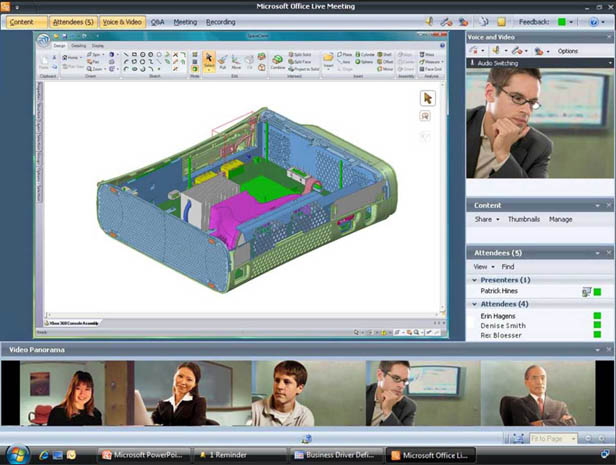
PLM Road Map 2009 event heralds transformation
Staff
General DPN The 16th PLM Road Map hosted by Collaborative Product Development Associates (CPDA) in Detroit in September addressed a PLM environment that has been radically transformed.
The 16th PLM Road Map hosted by Collaborative Product Development Associates (CPDA) in Detroit in September addressed a PLM environment that has been radically transformed.
Only ten years ago we thought primarily about improving collaboration across limited groups directly involved with design and product development.
Today, PLM targets the integration of product development efforts across all domains touched by development, for the full product lifecycle. Even more daunting, we are talking about a detailed reconciliation across expert domains that involve incredible complexity.

Walden Rhines, chairman and CEO of Mentor Graphics addressed automotive issues with his presentation, “Changing the Landscape of Vehicle E/E Design with Model-Driven Design.”
Dr. Walden C. Rhines, chairman and CEO of Mentor Graphics, opened the conference with his keynote on model-driven development (MDD). Given the escalating complexity confronted in product development, Dr. Rhines called for a paradigm shift for vehicle design (the conference was in Detroit, after all), through model-driven development.
MDD uses executable models to verify design, as defined at each level of abstraction, and automatically derives the design description for the next lower level. MDD can be applied to the entire system in a hierarchical fashion. This starts by defining system requirements and moving to functional elements mapped to the system architecture and to the requirements. At each hierarchical level of design, models support the ability to verify the design, much earlier than if waiting for the actual hardware implementation. Developers significantly reduce the risk to schedule, cost, and quality, by leveraging such a model-driven environment – a methodology that electronic design automation has pioneered and proven over the decades – and continue to evolve to address the challenges to industry.
{mospagebreak}Rated as the best individual presentation by conference attendees, Sanford Friedenthal of Lockheed Martin Corp. spoke about the transition in Systems Engineering from a document-based approach to a model-based approach. The emphasis shifts to the definition, management, and control of a coherent model of the system that can then be reflected in systems engineering documentation covering specifications, interface controls, system design, trade studies, and analysis results.
In the top-rated session at the conference, a panel of experts reviewed the emergence of requirements management as a primary driver for quality improvement across product development that directly helps to coordinate efforts across all disciplines. The rapid rate of innovation for requirements management across the full development cycle, however, raises major challenges in fully addressing the widening breadth of functionality and compounding detail demanded by leading users. Issues addressed by the panel included:
* Early development of requirements
* Sharing requirements across multiple disciplines
* Change traceability
* Requirements reuse
* Cultural challenges

Don Richardson, director, PLM Strategy at Microsoft Corp. discussed “Collaborative Product Information Networks.” His slide demonstrates the use of Microsoft Office Live Meeting, video and the SpaceClaim 3D visualization application to coordinate the product development process of an Xbox 360 console assembly.
A series of presentations covered the rising challenges faced in mechatronics development across mechanical, electronic and software disciplines. Design decisions for mechatronics require tight coordination between multi-disciplinary design and engineering activities to ensure the product delivers on all requirements and meets all constraints.
One panel considered three major areas of strategic challenges. First, defining the mechatronics design problem based upon shared views across the three domains of expertise – mechanical, electrical and software. All three must understand their interdependence for information, decision-making, and joint requirements.
Second, the definition of the mechatronics solution should represent an integrated system design to reconcile dependencies. Finally, the alignment and release of mechatronics deliverables should generate corresponding packages of information to manufacturing and services.
Presenting complementary mechatronics content, John Givens and Craig Brown spoke about different aspects of GM’s successful transformation of their engineering process in Powertrain with the Road to Lab to Math program.
While the track in simulation and data process management addressed a broad range of issues, Keith Meintjes of CPDA (www.cpd-associates.com) updated its analysis of vendors’ offerings with an extended scorecard covering the major vendors leading the effort. Five vendors participated in this effort – Altair, ANSYS, MSC.Software, Siemens PLM Software, and SIMULIA.
Almost all vendors in the sector already deliver solutions to the market, but a major question arises concerning deployment. Keith covered major advances in Simulation Data and Process Management as well as an analysis of major road blocks for solution deployment, and made recommendations on a road map for vendors and users.
Attendees rated the conference “thought-provoking,” supported by high quality presentations discussing important topics directly, and peripherally impacting the evolution of product lifecycle management. Download the presentations and listen to the audio with the following link:
https://cpd-associates.com/download/index.cfm?download=PLMRM09Proceedings
